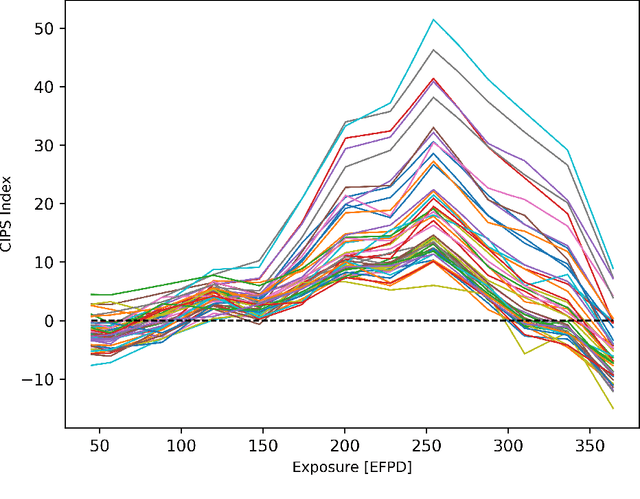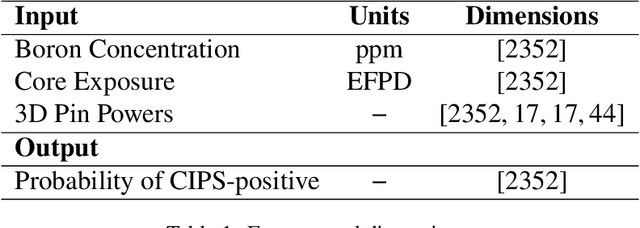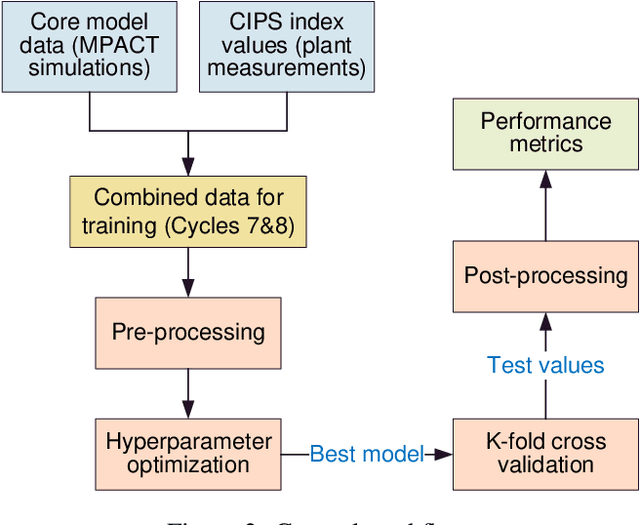Xu Wu
North Carolina State University
Nuclear Data Adjustment for Nonlinear Applications in the OECD/NEA WPNCS SG14 Benchmark -- A Bayesian Inverse UQ-based Approach for Data Assimilation
Sep 09, 2025Abstract:The Organization for Economic Cooperation and Development (OECD) Working Party on Nuclear Criticality Safety (WPNCS) proposed a benchmark exercise to assess the performance of current nuclear data adjustment techniques applied to nonlinear applications and experiments with low correlation to applications. This work introduces Bayesian Inverse Uncertainty Quantification (IUQ) as a method for nuclear data adjustments in this benchmark, and compares IUQ to the more traditional methods of Generalized Linear Least Squares (GLLS) and Monte Carlo Bayes (MOCABA). Posterior predictions from IUQ showed agreement with GLLS and MOCABA for linear applications. When comparing GLLS, MOCABA, and IUQ posterior predictions to computed model responses using adjusted parameters, we observe that GLLS predictions fail to replicate computed response distributions for nonlinear applications, while MOCABA shows near agreement, and IUQ uses computed model responses directly. We also discuss observations on why experiments with low correlation to applications can be informative to nuclear data adjustments and identify some properties useful in selecting experiments for inclusion in nuclear data adjustment. Performance in this benchmark indicates potential for Bayesian IUQ in nuclear data adjustments.
Seeing Sound, Hearing Sight: Uncovering Modality Bias and Conflict of AI models in Sound Localization
May 16, 2025Abstract:Imagine hearing a dog bark and turning toward the sound only to see a parked car, while the real, silent dog sits elsewhere. Such sensory conflicts test perception, yet humans reliably resolve them by prioritizing sound over misleading visuals. Despite advances in multimodal AI integrating vision and audio, little is known about how these systems handle cross-modal conflicts or whether they favor one modality. In this study, we systematically examine modality bias and conflict resolution in AI sound localization. We assess leading multimodal models and benchmark them against human performance in psychophysics experiments across six audiovisual conditions, including congruent, conflicting, and absent cues. Humans consistently outperform AI, demonstrating superior resilience to conflicting or missing visuals by relying on auditory information. In contrast, AI models often default to visual input, degrading performance to near chance levels. To address this, we finetune a state-of-the-art model using a stereo audio-image dataset generated via 3D simulations. Even with limited training data, the refined model surpasses existing benchmarks. Notably, it also mirrors human-like horizontal localization bias favoring left-right precision-likely due to the stereo audio structure reflecting human ear placement. These findings underscore how sensory input quality and system architecture shape multimodal representation accuracy.
Physics-Based Hybrid Machine Learning for Critical Heat Flux Prediction with Uncertainty Quantification
Feb 26, 2025Abstract:Critical heat flux is a key quantity in boiling system modeling due to its impact on heat transfer and component temperature and performance. This study investigates the development and validation of an uncertainty-aware hybrid modeling approach that combines machine learning with physics-based models in the prediction of critical heat flux in nuclear reactors for cases of dryout. Two empirical correlations, Biasi and Bowring, were employed with three machine learning uncertainty quantification techniques: deep neural network ensembles, Bayesian neural networks, and deep Gaussian processes. A pure machine learning model without a base model served as a baseline for comparison. This study examines the performance and uncertainty of the models under both plentiful and limited training data scenarios using parity plots, uncertainty distributions, and calibration curves. The results indicate that the Biasi hybrid deep neural network ensemble achieved the most favorable performance (with a mean absolute relative error of 1.846% and stable uncertainty estimates), particularly in the plentiful data scenario. The Bayesian neural network models showed slightly higher error and uncertainty but superior calibration. By contrast, deep Gaussian process models underperformed by most metrics. All hybrid models outperformed pure machine learning configurations, demonstrating resistance against data scarcity.
Native Fortran Implementation of TensorFlow-Trained Deep and Bayesian Neural Networks
Feb 07, 2025Abstract:Over the past decade, the investigation of machine learning (ML) within the field of nuclear engineering has grown significantly. With many approaches reaching maturity, the next phase of investigation will determine the feasibility and usefulness of ML model implementation in a production setting. Several of the codes used for reactor design and assessment are primarily written in the Fortran language, which is not immediately compatible with TensorFlow-trained ML models. This study presents a framework for implementing deep neural networks (DNNs) and Bayesian neural networks (BNNs) in Fortran, allowing for native execution without TensorFlow's C API, Python runtime, or ONNX conversion. Designed for ease of use and computational efficiency, the framework can be implemented in any Fortran code, supporting iterative solvers and UQ via ensembles or BNNs. Verification was performed using a two-input, one-output test case composed of a noisy sinusoid to compare Fortran-based predictions to those from TensorFlow. The DNN predictions showed negligible differences and achieved a 19.6x speedup, whereas the BNN predictions exhibited minor disagreement, plausibly due to differences in random number generation. An 8.0x speedup was noted for BNN inference. The approach was then further verified on a nuclear-relevant problem predicting critical heat flux (CHF), which demonstrated similar behavior along with significant computational gains. Discussion regarding the framework's successful integration into the CTF thermal-hydraulics code is also included, outlining its practical usefulness. Overall, this framework was shown to be effective at implementing both DNN and BNN model inference within Fortran, allowing for the continued study of ML-based methods in real-world nuclear applications.
An Investigation on Machine Learning Predictive Accuracy Improvement and Uncertainty Reduction using VAE-based Data Augmentation
Oct 24, 2024



Abstract:The confluence of ultrafast computers with large memory, rapid progress in Machine Learning (ML) algorithms, and the availability of large datasets place multiple engineering fields at the threshold of dramatic progress. However, a unique challenge in nuclear engineering is data scarcity because experimentation on nuclear systems is usually more expensive and time-consuming than most other disciplines. One potential way to resolve the data scarcity issue is deep generative learning, which uses certain ML models to learn the underlying distribution of existing data and generate synthetic samples that resemble the real data. In this way, one can significantly expand the dataset to train more accurate predictive ML models. In this study, our objective is to evaluate the effectiveness of data augmentation using variational autoencoder (VAE)-based deep generative models. We investigated whether the data augmentation leads to improved accuracy in the predictions of a deep neural network (DNN) model trained using the augmented data. Additionally, the DNN prediction uncertainties are quantified using Bayesian Neural Networks (BNN) and conformal prediction (CP) to assess the impact on predictive uncertainty reduction. To test the proposed methodology, we used TRACE simulations of steady-state void fraction data based on the NUPEC Boiling Water Reactor Full-size Fine-mesh Bundle Test (BFBT) benchmark. We found that augmenting the training dataset using VAEs has improved the DNN model's predictive accuracy, improved the prediction confidence intervals, and reduced the prediction uncertainties.
Low-Light Enhancement Effect on Classification and Detection: An Empirical Study
Sep 22, 2024Abstract:Low-light images are commonly encountered in real-world scenarios, and numerous low-light image enhancement (LLIE) methods have been proposed to improve the visibility of these images. The primary goal of LLIE is to generate clearer images that are more visually pleasing to humans. However, the impact of LLIE methods in high-level vision tasks, such as image classification and object detection, which rely on high-quality image datasets, is not well {explored}. To explore the impact, we comprehensively evaluate LLIE methods on these high-level vision tasks by utilizing an empirical investigation comprising image classification and object detection experiments. The evaluation reveals a dichotomy: {\textit{While Low-Light Image Enhancement (LLIE) methods enhance human visual interpretation, their effect on computer vision tasks is inconsistent and can sometimes be harmful. }} Our findings suggest a disconnect between image enhancement for human visual perception and for machine analysis, indicating a need for LLIE methods tailored to support high-level vision tasks effectively. This insight is crucial for the development of LLIE techniques that align with the needs of both human and machine vision.
Predicting Critical Heat Flux with Uncertainty Quantification and Domain Generalization Using Conditional Variational Autoencoders and Deep Neural Networks
Sep 09, 2024Abstract:Deep generative models (DGMs) have proven to be powerful in generating realistic data samples. Their capability to learn the underlying distribution of a dataset enable them to generate synthetic data samples that closely resemble the original training dataset, thus addressing the challenge of data scarcity. In this work, we investigated the capabilities of DGMs by developing a conditional variational autoencoder (CVAE) model to augment the critical heat flux (CHF) measurement data that was used to generate the 2006 Groeneveld lookup table. To determine how this approach compared to traditional methods, a fine-tuned deep neural network (DNN) regression model was created and evaluated with the same dataset. Both the CVAE and DNN models achieved small mean absolute relative errors, with the CVAE model maintaining more favorable results. To quantify the uncertainty in the model's predictions, uncertainty quantification (UQ) was performed with repeated sampling of the CVAE model and ensembling of the DNN model. Following UQ, the DNN ensemble notably improved performance when compared to the baseline DNN model, while the CVAE model achieved similar results to its non-UQ results. The CVAE model was shown to have significantly less variability and a higher confidence after assessment of the prediction-wise relative standard deviations. Evaluating domain generalization, both models achieved small mean error values when predicting both inside and outside the training domain, with predictions outside the training domain showing slightly larger errors. Overall, the CVAE model was comparable to the DNN regression model in predicting CHF values but with better uncertainty behavior.
Data-Driven Prediction and Uncertainty Quantification of PWR Crud-Induced Power Shift Using Convolutional Neural Networks
Jun 27, 2024



Abstract:The development of Crud-Induced Power Shift (CIPS) is an operational challenge in Pressurized Water Reactors that is due to the development of crud on the fuel rod cladding. The available predictive tools developed previously, usually based on fundamental physics, are computationally expensive and have shown differing degrees of accuracy. This work proposes a completely top-down approach to predict CIPS instances on an assembly level with reactor-specific calibration built-in. Built using artificial neural networks, this work uses a three-dimensional convolutional approach to leverage the image-like layout of the input data. As a classifier, the convolutional neural network model predicts whether a given assembly will experience CIPS as well as the time of occurrence during a given cycle. This surrogate model is both trained and tested using a combination of calculated core model parameters and measured plant data from Unit 1 of the Catawba Nuclear Station. After the evaluation of its performance using various metrics, Monte Carlo dropout is employed for extensive uncertainty quantification of the model predictions. The results indicate that this methodology could be a viable approach in predicting CIPS with an assembly-level resolution across both clean and afflicted cycles, while using limited computational resources.
CodeEnhance: A Codebook-Driven Approach for Low-Light Image Enhancement
Apr 08, 2024Abstract:Low-light image enhancement (LLIE) aims to improve low-illumination images. However, existing methods face two challenges: (1) uncertainty in restoration from diverse brightness degradations; (2) loss of texture and color information caused by noise suppression and light enhancement. In this paper, we propose a novel enhancement approach, CodeEnhance, by leveraging quantized priors and image refinement to address these challenges. In particular, we reframe LLIE as learning an image-to-code mapping from low-light images to discrete codebook, which has been learned from high-quality images. To enhance this process, a Semantic Embedding Module (SEM) is introduced to integrate semantic information with low-level features, and a Codebook Shift (CS) mechanism, designed to adapt the pre-learned codebook to better suit the distinct characteristics of our low-light dataset. Additionally, we present an Interactive Feature Transformation (IFT) module to refine texture and color information during image reconstruction, allowing for interactive enhancement based on user preferences. Extensive experiments on both real-world and synthetic benchmarks demonstrate that the incorporation of prior knowledge and controllable information transfer significantly enhances LLIE performance in terms of quality and fidelity. The proposed CodeEnhance exhibits superior robustness to various degradations, including uneven illumination, noise, and color distortion.
Clustering and Uncertainty Analysis to Improve the Machine Learning-based Predictions of SAFARI-1 Control Follower Assembly Axial Neutron Flux Profiles
Dec 20, 2023Abstract:The goal of this work is to develop accurate Machine Learning (ML) models for predicting the assembly axial neutron flux profiles in the SAFARI-1 research reactor, trained by measurement data from historical cycles. The data-driven nature of ML models makes them susceptible to uncertainties which are introduced by sources such as noise in training data, incomplete coverage of the domain, extrapolation and imperfect model architectures. To this end, we also aim at quantifying the approximation uncertainties of the ML model predictions. Previous work using Deep Neural Networks (DNNs) has been successful for fuel assemblies in SAFARI-1, however, not as accurate for control follower assemblies. The aim of this work is to improve the ML models for the control assemblies by a combination of supervised and unsupervised ML algorithms. The $k$-means and Affinity Propagation unsupervised ML algorithms are employed to identify clusters in the set of the measured axial neutron flux profiles. Then, regression-based supervised ML models using DNN (with prediction uncertainties quantified with Monte Carlo dropout) and Gaussian Process (GP) are trained for different clusters and the prediction uncertainty is estimated. It was found that applying the proposed procedure improves the prediction accuracy for the control assemblies and reduces the prediction uncertainty. Flux shapes predicted by DNN and GP are very close, and the overall accuracy became comparable to the fuel assemblies. The prediction uncertainty is however smaller for GP models.
 Add to Chrome
Add to Chrome Add to Firefox
Add to Firefox Add to Edge
Add to Edge